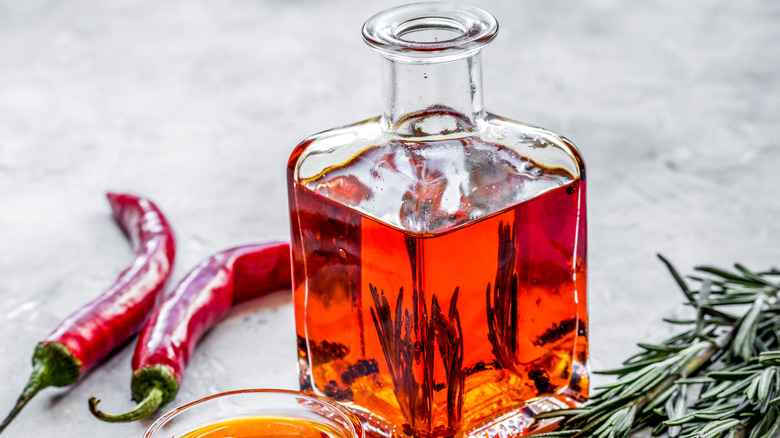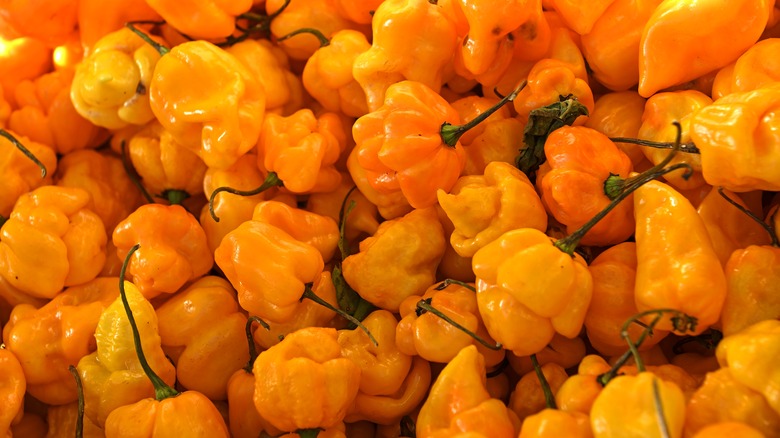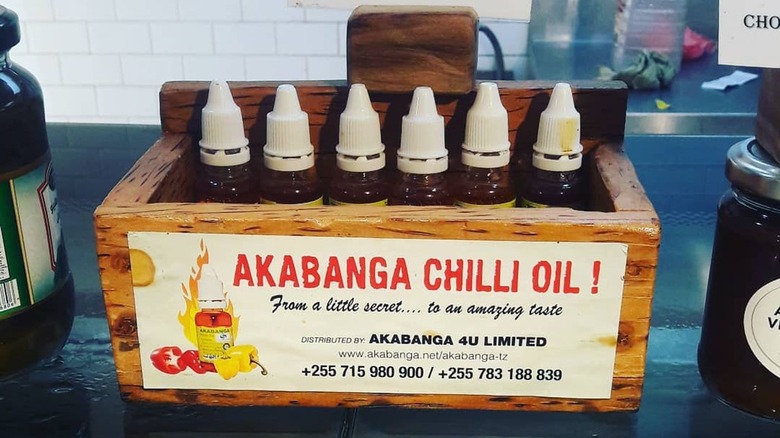Akabanga: The Rwandan Chili Oil That's So Spicy It's Sold In Dropper Bottles
This one goes out to all the thrill-seekers who love to dine in the hot seat. For some, a burning tongue, runny nose, and watery eyes are all part of the fun. If your attitude towards food is no pain, no gain, there's never been a better time to be alive. Spicy recipes are soaring in popularity and availability, and as Food & Beverage Insider reports, hot and spicy product rollouts have increased at a compound annual growth rate of 20% since the early 2010s. Social media has turned eating spicy food into a form of public theater, with trends like the Paqui One Chip Challenge bringing scores of sweaty red faces to our screens.
Spicy foods offer more than flavor, as the capsaicin they contain has potential health benefits that studies have linked to reduced mortality rates. Capsaicin is better known as the chemical in chili peppers that makes them spicy, and there is a unique way to measure it. The Scoville scale, named for the American pharmacist Wilbur Scoville, assigns a number to chili peppers based on their capsaicin content (via HowStuffWorks). The higher your food is on the scale, the hotter the burn. Jalepeños, for example, measure between 2,500 and 8,000 Scoville Heat Units (SHU). That alone can be too much for some, but what about something 60 times hotter?
Meet Akabanga chili oil
Akabanga clocks in a sweltering 150,000 SHU, according to the book "Gastro Obscura." It is sold in dropper bottles, similar to eye drops, in order to give consumers precise control over the heat level of their food. It is made by pressing the oil out of one of the hottest chili peppers out there, scotch bonnet. Swahili Market, a vendor of Akabanga chili oil, specifies that the condiment is 80% pure chili extract and 20% vegetable oil. The bright orange oil is so potent that workers must wear gloves and masks while making it (via "Gastro Obscura").
Akabanga was invented in the 1980s by a young street vendor named Sina Gerard, who specialized in a kind of savory donut called mandazi. According to "Gastro Obscura," he wanted to make his food stand out from the competition, so he invented a new condiment using locally-grown peppers, calling it Akabanga, which means "secret" in the local language. To call Akabanga a success would be an understatement, as Gerard was able to build a food empire off it. CNN reports that Gerard's business now produces Akabanga on an industrial scale, along with other products like fruit juice from local produce. The initiative made Gerard a millionaire, and he has funneled that fortune right back into his hometown, opening a school and supporting local farmers. CNN states that he may be the most famous businessman in Rwanda, all thanks to hot sauce.
Cooking with Akabanga
If you want to get a sense of how spicy Akabanga chili oil is, try a habanero. HowStuffWorks explains that habaneros and scotch bonnet chilis are about equal on the Scoville scale, both falling between 100,000 and 350,000 SHU. If you're a fan of habaneros, you're almost certain to love Akabanga, but this chili oil isn't just about spiciness. Atlas Obscura describes the oil as having a complex flavor profile with earthy, smoky notes. Although Akabanga packs a major punch when it first hits your tongue, Swahili Market adds, the heat doesn't linger as long as other hot sauces typically do.
Since it is meant for use as a condiment, there are really no limits to what you can do with Akabanga chili oil. Atlas Obscura notes that it is often used to deepen the flavors of soups, stews, and meats. However, the biggest fans of this potent potion are happy to put it on just about anything. The hidden benefit of the dropper bottle, as "Gastro Obscura" notes, is its portability. If you're eating in Rwanda, don't be surprised to see fellow diners reach into their pockets and produce their personal vial of the searing hot stuff.


